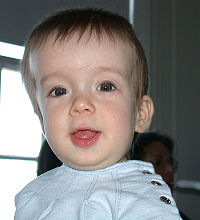
Photo from wikipedia
OBJECTIVE The aim of this study was to evaluate the impact of preoperative growth status on clinical outcomes of infantile living-donor liver transplantation (LDLT). METHODS From January 2009 to December… Click to show full abstract
OBJECTIVE The aim of this study was to evaluate the impact of preoperative growth status on clinical outcomes of infantile living-donor liver transplantation (LDLT). METHODS From January 2009 to December 2014, 131 LDLT recipients ≤1 year of age met the eligibility criteria of this study, of whom 31 patients with weight z-scores less than -2 constituted the abnormal growth group. Patients in the abnormal growth group were randomly matched (1:1) to patients with normal growth status by means of a multivariate case-matched method, and thus 31 patients in the normal growth group and 31 patients in the abnormal growth group were finally enrolled into the study. We compared the 2 groups regarding demographic characteristics, liver functions, postoperative complications, survival outcomes, and effects of catch-up growth. RESULTS Baseline characteristics were well matched between the 2 groups except that patients from the abnormal growth group were significantly inferior in terms of body weight (7.5 kg vs 6.0 kg; P < .01), height (65 cm vs 63 cm; P < .01), and body mass index (17.0 kg/m2 vs 14.8 kg/m2; P < .01) before LT. After LT, alanine transaminase, aspartate transaminase, alkaline phosphatase, γ-glutamyltransferase, albumin, and total bilirubin were all similar between the 2 groups. We also did not identify significant difference in any specific early complications or patient and graft survival rates (5-year: 90.2% vs 96.8%; P = .313). However, LT brought forth notable catch-up growth in both groups, especially for children with more serious growth retardation before LT. Differences of height z-scores between the 2 groups gradually diminished and lost significance 18 months after LT, and body weight z-scores between the 2 groups became similar 6 months after LT. CONCLUSIONS Preoperative growth status had no impact on liver function recovery, postoperative complications, or survival outcomes after infantile LDLT. Although biliary atresia caused severe growth impairment in infants, LT brought forth notable catch-up growth, especially for children with more serious growth retardation before LT.
Journal Title: Transplantation proceedings
Year Published: 2017
Link to full text (if available)
Share on Social Media: Sign Up to like & get
recommendations!